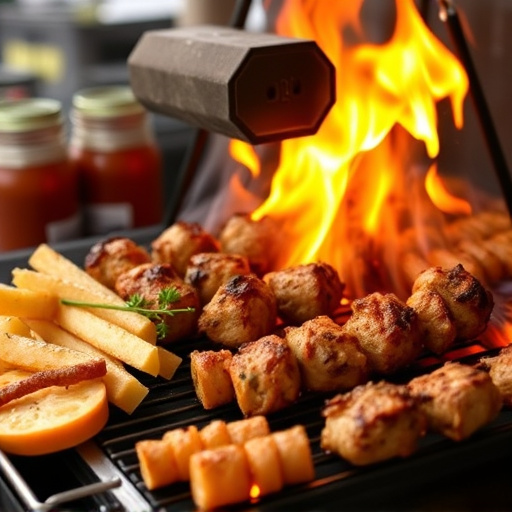Crafting perfect BBQ ribs starts with choosing the right cut—meaty, well-marbled, and slightly fatty—for slow cooking. Three main styles include baby back, spare, and St. Louis-style ribs, each with unique seasoning techniques. Freshness is key; dry-age ribs for 2-4 weeks in the fridge to intensify flavor and tenderness. Marinate or rub with paprika, garlic powder, salt, pepper, brown sugar, or honey for at least 24 hours before grilling. Dry-aging and marinating elevate taste and texture, making your recipe for BBQ ribs truly gourmet.
“Unleash the ultimate summer delight with a mouthwatering journey through the perfect grilled rib recipe. From choosing the right cuts like baby back, spare rib, or St. Louis style to mastering dry-aging and marinating techniques, this guide is your secret weapon. Learn how to achieve that coveted glaze and smoke-ringed perfection on the grill. With sections dedicated to preparation, grilling, glazing, and finishing touches, we’ll walk you through every step to create a memorable BBQ rib experience that’s sure to impress.”
- Choosing the Right Ribs
- – Types of ribs: baby back, spare rib, and St. Louis style
- – Selecting quality ribs: marbling, meat tenderness, and freshness
- Preparation: Dry-Aging and Marinating
- – Benefits of dry-aging ribs for enhanced flavor and tenderness
Choosing the Right Ribs

When it comes to crafting the perfect recipe for BBQ ribs, starting with the right cut is essential. Look for meaty, well-marbled ribs with a good amount of fat. The fat adds flavor and keeps the ribs tender during the slow cooking process. Traditional options include baby back or spare rib cuts, both of which offer a balance of meat to bone and are ideal for grilling.
Consider the source too—pork ribs from grass-fed, free-range pigs tend to pack more intense flavors. At the core of any great BBQ ribs recipe is patience; slow cooking allows the meat to melt off the bone. This process requires time, but it’s key to achieving those tender, juicy results you crave.
– Types of ribs: baby back, spare rib, and St. Louis style

When it comes to BBQ ribs, there are three main styles that food enthusiasts love to debate and enjoy. Each has its unique characteristics that make it a favorite among grill masters. Baby back ribs, as the name suggests, come from the baby back section of the pig and have a smaller bone structure with less meat on the bone. They’re known for their tender, meaty texture and are often preferred for a simple dry rub before grilling, allowing the natural flavors to shine.
Spare ribs, or spare rib cuts, are larger and have a more prominent bone structure. These ribs require slow cooking to break down the connective tissues, resulting in incredibly tender meat that practically falls off the bone. A popular choice for BBQ lovers, spare ribs often benefit from a glaze or sauce during the grilling process for added flavor and moisture. St. Louis-style ribs are another favorite, distinguished by their thin, meaty cut and often finished with a wet rub or sauce, giving them a glistening appearance and a rich, tangy taste. Whether you’re making a recipe for BBQ ribs or trying out a new glaze, understanding these rib styles can elevate your grilling game.
– Selecting quality ribs: marbling, meat tenderness, and freshness

When it comes to crafting the perfect recipe for BBQ ribs, selecting quality ribs is the cornerstone. Look for ribs with visible marbling—the streaks of fat running through the meat—as this contributes to a rich, juicy flavor. Opt for ribs that have a good balance of meat and bone, ensuring meaty sections that will tenderize during cooking. Freshness is paramount; choose ribs from reputable sources that guarantee their freshness, which can significantly enhance the overall taste experience.
The tenderness of the meat is another key factor. Choose ribs that are slightly more marbled but not overly fatty, as this ensures they’ll break down easily during the slow-cooking process, resulting in tender, succulent rib meat that glistens with flavor. Properly stored, refrigerated ribs will maintain their quality for several days, allowing you to prepare a mouthwatering BBQ ribs recipe with consistent results.
Preparation: Dry-Aging and Marinating

When preparing juicy, grill-finished ribs, dry-aging and marinating are key steps to enhance flavor. Dry-aging involves removing moisture from the meat, which can take anywhere from 2-4 weeks in the refrigerator. This process helps intensify the rib’s natural taste and makes them tenderer when cooked. After dry-aging, a marinade or rub is essential to further moisten and season the ribs. A good recipe for BBQ ribs should include a balance of spices like paprika, garlic powder, salt, and pepper, often combined with ingredients like brown sugar or honey for a sweet and savory glaze.
Soak the ribs in the marinade for at least 24 hours before grilling to ensure maximum absorption of flavors. This step will not only add moisture but also help break down some of the meat’s fibers, resulting in tender, succulent ribs when grilled to perfection.
– Benefits of dry-aging ribs for enhanced flavor and tenderness

Dry-aging is a technique that enhances the flavor and overall quality of BBQ ribs, making it an essential step in many professional chefs’ processes. By removing moisture from the meat over time, dry-aging allows enzymes to break down connective tissues, resulting in more tender ribs. This process also develops a deeper, richer flavor profile, transforming ordinary ribs into a culinary delight.
When preparing a recipe for BBQ ribs, considering dry-aging can take your dish to the next level. It’s a simple yet effective method that requires patience but offers remarkable results. The process typically involves sealing the ribs in a vacuum bag and storing them in a controlled environment for several days or even weeks, ensuring a mouthwatering experience for rib enthusiasts.
